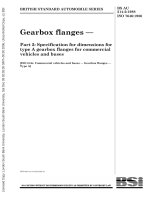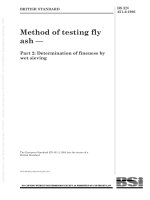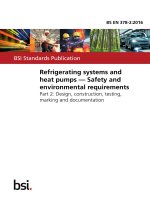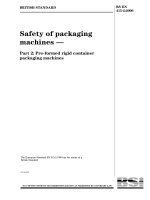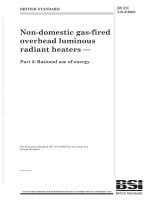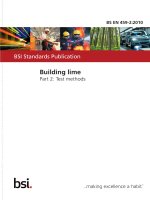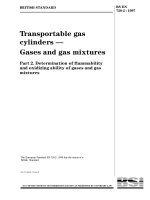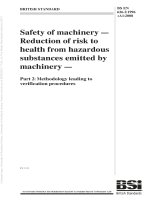Bsi bs en 61207 2 1994 (1999)
Bạn đang xem bản rút gọn của tài liệu. Xem và tải ngay bản đầy đủ của tài liệu tại đây (423.99 KB, 16 trang )
BRITISH STANDARD
Expression of
performance of gas
analyzers —
Part 2: Oxygen in gas (utilizing
high-temperature electrochemical
sensors)
The European Standard EN 61207-2:1994 has the status of a
British Standard
UDC 621.317.79:543.27:543.25
BS EN
61207-2:1994
IEC 1207-2:
1994
BS EN 61207-2:1994
Cooperating organizations
The European Committee for Electrotechnical Standardization (CENELEC),
under whose supervision this European Standard was prepared, comprises the
national committees of the following countries:
Austria
Belgium
Denmark
Finland
France
Germany
Greece
Iceland
Ireland
This British Standard, having
been prepared under the
direction of the Electrotechnical
Sector Board, was published
under the authority of the
Standards Board and comes
into effect on
15 November 1994
© BSI 11-1999
The following BSI references
relate to the work on this
standard:
Committee reference PCL/Draft for comment 85/21733 DC
ISBN 0 580 23514 9
Italy
Luxembourg
Netherlands
Norway
Portugal
Spain
Sweden
Switzerland
United Kingdom
Amendments issued since publication
Amd. No.
Date
Comments
BS EN 61207-2:1994
Contents
Cooperating organizations
National foreword
Foreword
Text of EN 61207-2
National annex NA (informative) Committees responsible
National annex NB (informative) Cross-references
© BSI 11-1999
Page
Inside front cover
ii
2
3
Inside back cover
Inside back cover
i
BS EN 61207-2:1994
National foreword
This British Standard has been prepared under the direction of the
Electrotechnical Sector Board and is the English language version of
EN 61207-2:1994 Expression of performance of gas analyzers. Part 2: Oxygen in
gas (utilizing high-temperature electrotechnical sensors), published by the
European Committee for Electrotechnical Standardization (CENELEC). It is
identical with IEC 1207-2:1994 including Corrigendum, May 1994, published by
the International Electrotechnical Commission (IEC).
IEC 1207-2 constitutes Part 2 of the IEC 1207 series of publications under the
general title: Expression of performance of gas analyzers. Other Parts are as
follows:
— Part 1: General;
— Part 2: Oxygen in gas (utilizing high-temperature electrotechnical sensors);
— Part 6: Photometric analyzers;
— Part 7: Infra-red analyzers.
Parts 3, 4 and 5 are under consideration.
The following print types are used in this standard:
— requirements proper: in roman type;
— notes: in smaller roman type.
A British Standard does not purport to include all the necessary provisions of a
contract. Users of British Standards are responsible for their correct application.
Compliance with a British Standard does not of itself confer immunity
from legal obligations.
Summary of pages
This document comprises a front cover, an inside front cover, pages i and ii,
the EN title page, pages 2 to 10, an inside back cover and a back cover.
This standard has been updated (see copyright date) and may have had
amendments incorporated. This will be indicated in the amendment table on the
inside front cover.
ii
© BSI 11-1999
EUROPEAN STANDARD
EN 61207-2
NORME EUROPÉENNE
June 1994
EUROPÄISCHE NORM
UDC 621.317.79:543.27:543.25
Descriptors: Gaseous mixtures, oxygen in gaseous mixtures, gas analyzers, performance of gas analyzers, high temperature
electrochemical sensors
English version
Expression of performance of gas analyzers
Part 2: Oxygen in gas (utilizing high-temperature
electrochemical sensors)
(IEC 1207-2:1994 + corrigendum 1994)
Expression des qualités de fonctionnement
des analyseurs de gaz
Partie 2: Oxygène contenu dans le gaz
(utilisant des capteurs électrochimiques à
haute température)
(CEI 1207-2:1994)
Angabe zum Betriebsverhalten von
Gasanalysatoren
Teil 2: Sauerstoff in Gas (unter Verwendung
von elektrochemischen
Hochtemperatur-Sensoren)
(IEC 1207-2:1994)
This European Standard was approved by CENELEC on 1994-05-15.
CENELEC members are bound to comply with the CEN/CENELEC Internal
Regulations which stipulate the conditions for giving this European Standard
the status of a national standard without any alteration.
Up-to-date lists and bibliographical references concerning such national
standards may be obtained on application to the Central Secretariat or to any
CENELEC member.
This European Standard exists in three official versions (English, French,
German). A version in any other language made by translation under the
responsibility of a CENELEC member into its own language and notified to the
Central Secretariat has the same status as the official versions.
CENELEC members are the national electrotechnical committees of Austria,
Belgium, Denmark, Finland, France, Germany, Greece, Iceland, Ireland, Italy,
Luxembourg, Netherlands, Norway, Portugal, Spain, Sweden, Switzerland and
United Kingdom.
CENELEC
European Committee for Electrotechnical Standardization
Comité Européen de Normalisation Electrotechnique
Europäisches Komitee für Elektrotechnische Normung
Central Secretariat: rue de Stassart 35, B-1050 Brussels
© 1994 Copyright reserved to CENELEC members
Ref. No. EN 61207-2:1994 E
EN 61207-2:1994
Foreword
Contents
The text of document 65D(CO)3, as prepared by
Subcommittee 65D: Analyzing equipment, of IEC
Technical Committee 65: Industrial-process
measurement and control, was submitted to the
IEC-CENELEC parallel vote in October 1993.
The reference document was approved by
CENELEC as EN 61207-2 on 15 May 1994.
The following dates were fixed:
— latest date of publication
of an identical national
standard
— latest date of withdrawal
of conflicting national
standards
(dop) 1995-05-15
(dow) 1995-05-15
For products which have complied with the relevant
national standard before 1995-05-15, as shown by
the manufacturer or by a certification body, this
previous standard may continue to apply for
production until 2000-05-15.
Annexes designated “normative” are part of the
body of the standard. Annexes designated
“informative” are given only for information. In this
standard, Annex ZA is normative.
2
Foreword
Introduction
1
Scope
2
Normative references
3
Definitions
4
Procedures for specification
4.1 Specification of essential units and
ancillary services
4.2 Additional terms related to the
specification of performance
4.3 Important terms related to the
specification of performance
5
Procedures for compliance testing
5.1 General
5.2 Testing procedures
5.3 Output fluctuation
5.4 Delay time, rise time and fall time
Annex ZA (normative) Other international
publications quoted in this standard with
the references of the relevant European
publications
Figure 1 — General test arrangement, in situ
analyser
Figure 2 — General test arrangement,
extractive analyzer
Page
2
3
3
3
3
5
5
5
5
6
6
6
6
6
10
8
9
© BSI 11-1999
EN 61207-2:1994
Introduction
2 Normative references
This part of IEC 1207 includes the terminology,
definitions, statements and tests that are specific to
oxygen analyzers, which utilise high-temperature
electrochemical sensors.
Oxygen analyzers employing high-temperature
electrochemical sensors operating at temperatures
usually in excess of 600 °C, have a wide range of
applications for the measurement of oxygen in gas
samples. Such samples are typically the result of a
combustion process.
Two main types of analyzer exist, the in situ
analyzer, where the sensor is positioned within the
process duct work, and the “extractive” analyzer,
where the sample is drawn from the duct via a
simple sample system and presented to the sensor.
An analyzer will typically comprise a sensor head,
mounted on the process duct, and a control unit
remotely mounted, with interconnecting cable.
The following normative documents contain
provisions which, through reference in this text,
constitute provisions of this part of IEC 1207. At the
time of publication, the editions indicated were
valid. All normative documents are subject to
revision, and parties to agreements based on this
part of IEC 1207 are encouraged to investigate the
possibility of applying the most recent editions of
the normative documents indicated below. Members
of IEC and ISO maintain registers of currently valid
International Standards.
IEC 654, Operating conditions for industrial-process
measurement and control equipment.
IEC 1207-1:1994, Expression of performance of gas
analyzers — Part 1: General.
1 Scope
The high-temperature electrochemical sensor can
be constructed in two basic forms:
a) Galvanic concentration cell.
b) Ion pump cell.
This part of IEC 1207 applies to all aspects of
analyzers using high-temperature electrochemical
sensors for the measurement of oxygen in gas. It
should be used in conjunction with IEC 1207-1.
It applies to in-situ and extractive analyzers and to
analyzers installed indoors and outdoors.
The object of this part is:
— to specify the terminology and definitions
related to the functional performance of gas
analyzers, utilizing a high-temperature
electrochemical sensor, for the continuous
measurement of oxygen concentration in a
sample of gas;
— to unify methods used in making and verifying
statements on the functional performance of such
analyzers;
— to specify what tests should be performed to
determine the functional performance and how
such tests should be carried out;
— to provide basic documents to support the
application of standards of quality assurance
ISO 9001, ISO 9002 and ISO 9003.
3 Definitions
3.1 High-temperature electrochemical sensor
3.1.1
galvanic concentration cell
most commercially available analyzers employ the
galvanic concentration cell consisting of two gas
chambers, separated by an oxygen ion conducting
solid electrolyte, and provided with a porous
electrode on each side
NOTE 1 Platinum is frequently used for the electrodes, and the
ceramic electrolyte is usually zirconium oxide, fully or partially
stabilized with yttrium oxide, calcium oxide or thorium oxide,
which when heated above 600 °C, allows the charge transfer
mechanism to be predominantly oxygen ion conduction.
NOTE 2 When the sensor is brought to a temperature at which
the solid electrolyte conducts oxygen ions and the e.m.f. between
the two electrodes is measured, the output will be related to the
logarithm of the ratio of the partial pressures of oxygen at each of
the electrodes in accordance with the Nernst equation:
(1)
(2)
(3)
where
© BSI 11-1999
P1
is the partial pressure of oxygen in the reference gas;
P2
is the partial pressure of oxygen in the sample gas;
E
is the electromotive force output from the cell in V;
R
is the gas constant (8,3144 J K–1 mol–1);
T
is the absolute temperature (K);
F
is the Faraday constant (96,484 56 × 103 C mol–1);
k
is the Nernstian coefficient (slope factor).
3
EN 61207-2:1994
Thus, provided the oxygen partial pressure is known at one
electrode (P1), then the potential difference between the two
electrodes will enable the unknown oxygen pressure to be
determined at the other electrode (P2).
The Nernstian response of the high-temperature electrochemical
ceramic sensor holds over a very wide range of oxygen partial
pressures differences, and the sensor output increases
logarithmically with linear reduction of the oxygen partial
pressure at a given temperature. The sensor output is directly
proportional to temperature, and hence for quantitative analysis,
the temperature of the cell should be closely controlled or
measured, and the necessary corrections applied in equation (1).
NOTE 3 Zero offset
Theoretically the output e.m.f. of the sensor, when the partial
pressures of the sample gas and reference gas are equal, is zero
volts. In some sensors a zero offset is measured and is considered
largely due to thermoelectric effects, and thermal gradients
across the electrodes. This offset can be considered theoretically
as an extra constant (asymmetry potential).
(4)
(5)
is the asymmetry potential (mV).
Non-ideal oxygen ion conduction can also be compensated for by
introducing modifications to the slope factor k.
In practice, manufacturers whose sensors exhibit zero offset may
supply practical average values of U to help in calibration.
Modern equipment will automatically compensate the
asymmetry potential during air point calibration (i.e. air in both
chambers).
3.1.2 ion pump cell
If a direct current is made to flow between the
electrodes of a cell, with air in one chamber and an
inert gas in the other chamber, the current flow will
cause a pumping of oxygen molecules from one side
to the other. The action obeys Faraday’s laws and
the quantity of oxygen pumped by diffusion into the
inert gas is given by:
(6)
where
Q is the quantity of oxygen pumped in mol s–1;
I
is the current (A);
F is the Faraday constant (96,484 56 × 103
C mol–1).
This is used generally in two basic configurations.
3.1.2.1
limiting current
a diffusion pinhole limits the rate of arrival of
oxygen molecules at the measuring electrode, and a
constant voltage across the electrodes ensures that
all the oxygen arriving at the measuring electrode is
pumped to the other side. The current generated is
quantitatively related to the number of oxygen
molecules transferred
4
this configuration consists of two sets of electrodes
arranged across a small fixed volume. The first set
comprises a concentration cell, the second set the
ion pump. The volume is initially swept of oxygen
molecules to a predetermined low level. Pump
action is then initiated until the concentration cell
reading shows that the oxygen concentration in the
volume and that outside at the sample side, are the
same. The current and time required to achieve this
are related to the oxygen concentration of the
sample gas
3.2
reference gas
all analyzers using the high-temperature
electrochemical concentration cell require a
reference sample of known and constant
composition — usually air is employed
NOTE The sensor output is a function of the partial pressure of
oxygen in the sample, provided the reference has a constant
partial pressure of oxygen.
where
UT
3.1.2.2
fixed volume
3.3
in situ analyzer
the in situ analyzer has the high-temperature
electrochemical sensor situated in the sample;
however the sensor may require a filter to remove
particulates
one version of the in situ analyzer controls the
temperature of the sensor in the range 600 °C
to 800 °C. In this case the sample temperature
cannot exceed the control temperature. The second
version relies on the temperature of the sample to
attain the operating temperature. It is then
necessary to measure the sensor temperature to
enable the oxygen value to be calculated
3.4
extractive analyzer
in the “extractive” analyzer the sensor head is
installed outside the gas stream to be measured,
and the sample is drawn through a sample probe
and presented to the sensor which is maintained at
a controlled temperature to ensure ionic conduction
(typically in the range 600 °C to 800 °C)
the extractive analyzer may require a filter to
remove particulates, and a driving force (often an
aspirator) to move the sample. The pipework
involved should be minimized and maintained
above the dew-point of any condensible species to
prevent formation of any condensation
© BSI 11-1999
EN 61207-2:1994
3.5
hazardous area
an area where there is a possibility of release of
potential flammable gases, vapours or dusts
3.6
flametrap
a device used to prevent a flame, resulting from the
ignition of a flammable gas mixture, from
propagating
3.7
essential ancillary units
essential ancillary units are those without which
the analyzer will not operate (e.g. pumps for
aspirators, calibration systems, etc.)
4 Procedures for specification
The procedures for specification are detailed in
IEC 1207-1. This covers:
— operation and storage requirements;
— specification of ranges of measurement and
output signals;
— limits of errors;
— recommended reference values and rated
ranges of influence quantities.
In this part of IEC 1207, specifications of ranges for
ancillary equipment are given. Additional terms for
specification of performance, and important aspects
of performance relevant to high-temperature
electrochemical sensors are also detailed.
4.1 Specification of essential units and
ancillary services
All oxygen analyzers utilizing high-temperature
electrochemical concentration cells require a
reference gas supply. This is usually air, filtered to
remove moisture and oil. Analyzers require
facilities for calibration after installation. Bottled
calibration gases and pressure regulation facilities
are generally required.
4.1.1 Rated range of reference gas pressure
Reference gas pressure in practice may have small
effects on error.
Also the reference gas pressure will affect reference
gas flow. High flows can cause cooling of electrodes
and subsequent errors.
© BSI 11-1999
4.1.2 Rated range of calibration gas pressure
Calibration gas pressure may have small effects on
error. Also calibration gas pressure will affect
calibration gas flow in a similar manner as
described in 4.1.1.
4.1.3 Rated range of aspirator gas pressure
For analyzers employing aspirators, the rated range
of aspirator gas pressure is required to ensure
correct sample flow (and sometimes reference air
flow).
4.2 Additional terms related to the
specification of performance
The following additional statements may be
required to define the performance of the analyzer.
Dependent on the design details, some of these
additional terms may be omitted.
4.2.1 Hazardous classification of the area in which
the sensor head and electronic unit are to be located.
General purpose analyzers will not be suitable for
location in hazardous areas.
4.2.2 As the high-temperature electrochemical
sensor is a potential ignition source, the additional
statement on the permissible level of flammable gas
in the sample is required.
NOTE Many analyzers are designed to prevent ignition of the
sample gas, for example by using flametraps.
4.2.3 Sensor life expectancy
The high-temperature electrochemical sensor has a
finite life expectancy and will require occasional
replacement. The actual cell life will be dependent
on the sample.
4.3 Important terms related to the
specification of performance
Although covered in IEC 1207-1, the following terms
are particularly relevant.
4.3.1 Rated range of sample gas temperature
In an in situ analyzer, operation will only be
satisfactory within the rated range of sample gas
temperatures. In an extractive analyzer the
extraction probe will only be suitable within the
rated range of sample gas temperature.
4.3.2 Rated range of sample gas pressure
In certain analyzer designs of the extractive type,
sample pressure is important if the sample is vented
to atmosphere. The sample gas pressure must be
within the rated range to ensure sample flow.
5
EN 61207-2:1994
4.3.3 Rated range of interfering components
NOTE 1 If a high-temperature electrochemical sensor is used to
measure the oxygen content of a gaseous mixture which contains
moisture and gases capable of being oxidized at the operating
temperature of the sensor, then the oxygen content figures
obtained using a high-temperature electrochemical sensor will
always be lower than those obtained when using an analyzer
based on measuring a preconditioned dry sample (e.g. a
paramagnetic oxygen analyzer).
This is due to two facts:
a) Oxygen is consumed at the high-temperature cell surface in
accordance with the oxidation reaction associated with the
oxidizable gas.
b) There are sample volume differences — the electrochemical
cell uses the wet gas basis whilst the paramagnetic analyzer
uses the dry gas basis because any water vapour in the source
gas is removed prior to measurement.
NOTE 2 It is important to understand that inherently the
selectivity of the zirconium oxide, based on the property of oxygen
ion mobility, makes direct interferences not possible. Indirect
interferences may occur of the type in note 1 above, or by
screening effects, or by parasitic chemical reactions. Also oxygen
based substances which thermally decompose at the cell
operating temperature would obviously interfere with the O2
determination.
NOTE 3 Some substances can poison the high-temperature
electrochemical cell in a permanent manner, thereby reducing
the sensitivity of the cell to oxygen to zero. For example free
halogens, certain sulphur compounds, silicones, and lead are
commonly recognized poisons.
5 Procedures for compliance testing
5.1 General
In order for a high-temperature electrochemical
sensor to be used for the quantitative analysis of
oxygen in a source, the sensor unit must be
maintained at a constant temperature, or the
analyzer should measure the temperature of the
sensor and carry out the necessary correction for
any variation in the temperature.
The tests given in this clause apply to the complete
analyzer as supplied by the manufacturer and
includes all necessary ancillary equipment to
ensure its correct functioning. It will be set up by the
manufacturer, or in accordance with his
instructions, prior to testing.
The calibration of the sensor head can usually be
carried out using two methods. The first method
utilizes a calibration chamber in which the sensor is
enclosed and the calibration gas is then passed into
the chamber.
This represents the sampling of calibration gases as
if they were the sample. The second method utilizes
the normal calibration facility, as designed into the
analyzer, whereby the calibration gas is injected on
to the sensor without removing it from its working
environment. Figure 1 shows the general test
arrangements for the in situ analyzer and Figure 2
for the extractive analyzer.
6
Both calibration methods should be used initially.
Providing the results obtained by each method are
within acceptable limits, the normal calibration
facility should be used for all other tests except the
response time test.
Air is used as the reference and zero gas. Three
other calibration gases representing
approximately 10 %, 50 %, and 90 % of the
measuring range shall be used. The composition of
the calibration gases should be traceable to an
accepted standard or checked by independent
means. (See IEC 1207-1, for relevant standards.)
5.2 Testing procedures
The following relevant testing procedures are
detailed in IEC 1207-1:
— intrinsic error;
— linearity error;
— repeatability error;
— output fluctuation;
— drift;
— delay time, rise time, and fall time;
— interference error;
— variation (influence error);
— warm-up time.
The ancillary equipment, necessary for the correct
functioning of the analyzer, will be maintained
under reference conditions.
Additional test details for analyzers utilizing
high-temperature electrochemical sensors are given
below.
5.3 Output fluctuation
The output fluctuation depends on the level of
oxygen to be measured. The analyzer is presented
with an agreed test gas and the test procedure
detailed in 5.6.4 of IEC 1207-1, is used. The
minimum detectable change is taken as twice the
output fluctuation.
5.4 Delay time, rise time and fall time
NOTE 1 For in situ and for extractive analyzers, the calibration
gas can be introduced directly on to the sensor unit, via the
calibration facility, thus giving the delay time and the 90 %
response time of the sensor. It can also be introduced as a sample,
thus giving the lag time and 90 % response time of the system.
NOTE 2 The manufacturers’ recommended flow rate should be
used.
NOTE 3 The time constants should be determined for the linear
oxygen signal.
© BSI 11-1999
EN 61207-2:1994
For test method, see 5.6.6 of IEC 1207-1, or the
following:
The 10 % and 90 % span oxygen in nitrogen
calibration gas are connected to the inlet of the
system via a three-way valve and standard steel
tubing (see Figure 1 and Figure 2). The gas sample
lines from the valve to the system inlet should be
kept as short as possible.
Whilst the analyzer output is recorded, the analyzer
is exposed to the 10 % test gas until a constant
output reading is obtained. The 90 % calibration gas
is then introduced at the analyzer inlet and the
recorder chart marked when the three-way valve is
moved to accomplish this. Gas flow is continued
until a constant reading is obtained.
The 10 % calibration gas is again introduced at the
analyzer inlet and the recorder chart marked when
the changeover valve is moved to accomplish this.
Gas flow is continued until a constant reading is
obtained.
© BSI 11-1999
The values for the delay time, rise time, and fall
time are determined from the chart, through
knowledge of the recorder chart speed.
The value of the 90 % response time is obtained in
both an upscale and downscale direction by the
addition of the delay time, and the rise time or fall
time.
NOTE 4 For extractive analyzers the values so determined
represent the delay time, rise time, and fall times for sample
gases at ambient temperature. When the sample is at high
temperature (i.e. in the range 250 °C to 1 800 °C), and depending
on the length and internal diameter of the sample probe, the
values will be reduced by up to a factor of 2,5 due to the change
in density of the sample.
7
EN 61207-2:1994
8
© BSI 11-1999
Figure 1 — General test arrangement, in situ analyser
© BSI 11-1999
9
EN 61207-2:1994
Figure 2 — General test arrangement, extractive analyzer
EN 61207-2:1994
Annex ZA (normative)
Other international publications quoted in this standard with the references of
the relevant European publications
This European Standard incorporates by dated or undated reference, provisions from other publications.
These normative references are cited at the appropriate places in the text and the publications are listed
hereafter. For dated references, subsequent amendments to or revisions of any of these publications apply
to this European Standard only when incorporated in it by amendment or revision. For undated references
the latest edition of the publications referred to applies.
NOTE When the international publication has been modified by CENELEC common modifications, indicated by (mod), the relevant
EN/HD applies.
IEC publication
Date
Title
EN/HD
Date
654
series
series
1994
Industrial-process measurement and control
equipment — Operating conditions
Expression of performance of gas analyzers —
Part 1: General
EN 60654
HD 413
EN 61207-1
series
series
1994
1207-1
10
© BSI 11-1999
BS EN 61207-2:1994
National annex NA (informative)
Committees responsible
The United Kingdom participation in the preparation of this European Standard was entrusted by the
Electrotechnical Sector Board to Technical Committee PCL/1, upon which the following bodies were
represented:
British Coal Corporation
British Gas plc
British Telecommunications plc
Department of Trade and Industry (Gas and Oil Measurement Branch)
Electrical Contractors Association
Electricity Association
Energy Industries Council
Engineering Equipment and Materials Users Association
GAMBICA (BEAMA Ltd.)
Health and Safety Executive
Institution of Gas Engineers
The following body was also represented in the drafting of the standard, through subcommittees:
Department of Trade and Industry (National Physical Laboratory)
National annex NB (informative)
Cross-references
Publication referred to
Corresponding British Standard
EN 60654
(IEC 654)
BS EN 60654 Industrial-process measurement and control equipment. Operating
conditions
BS EN 60654-1:1993 Climatic conditions
BS EN 61207 Expression of performance of gas analyzers
BS EN 61207-1:1994 General
EN 61207-1
(IEC 1207-1)
© BSI 11-1999
BS EN
61207-2:1994
IEC 1207-2:
1994
BSI — British Standards Institution
BSI is the independent national body responsible for preparing
British Standards. It presents the UK view on standards in Europe and at the
international level. It is incorporated by Royal Charter.
Revisions
British Standards are updated by amendment or revision. Users of
British Standards should make sure that they possess the latest amendments or
editions.
It is the constant aim of BSI to improve the quality of our products and services.
We would be grateful if anyone finding an inaccuracy or ambiguity while using
this British Standard would inform the Secretary of the technical committee
responsible, the identity of which can be found on the inside front cover.
Tel: 020 8996 9000. Fax: 020 8996 7400.
BSI offers members an individual updating service called PLUS which ensures
that subscribers automatically receive the latest editions of standards.
Buying standards
Orders for all BSI, international and foreign standards publications should be
addressed to Customer Services. Tel: 020 8996 9001. Fax: 020 8996 7001.
In response to orders for international standards, it is BSI policy to supply the
BSI implementation of those that have been published as British Standards,
unless otherwise requested.
Information on standards
BSI provides a wide range of information on national, European and
international standards through its Library and its Technical Help to Exporters
Service. Various BSI electronic information services are also available which give
details on all its products and services. Contact the Information Centre.
Tel: 020 8996 7111. Fax: 020 8996 7048.
Subscribing members of BSI are kept up to date with standards developments
and receive substantial discounts on the purchase price of standards. For details
of these and other benefits contact Membership Administration.
Tel: 020 8996 7002. Fax: 020 8996 7001.
Copyright
Copyright subsists in all BSI publications. BSI also holds the copyright, in the
UK, of the publications of the international standardization bodies. Except as
permitted under the Copyright, Designs and Patents Act 1988 no extract may be
reproduced, stored in a retrieval system or transmitted in any form or by any
means – electronic, photocopying, recording or otherwise – without prior written
permission from BSI.
This does not preclude the free use, in the course of implementing the standard,
of necessary details such as symbols, and size, type or grade designations. If these
details are to be used for any other purpose than implementation then the prior
written permission of BSI must be obtained.
BSI
389 Chiswick High Road
London
W4 4AL
If permission is granted, the terms may include royalty payments or a licensing
agreement. Details and advice can be obtained from the Copyright Manager.
Tel: 020 8996 7070.
